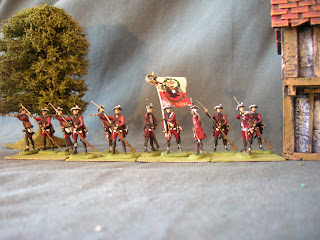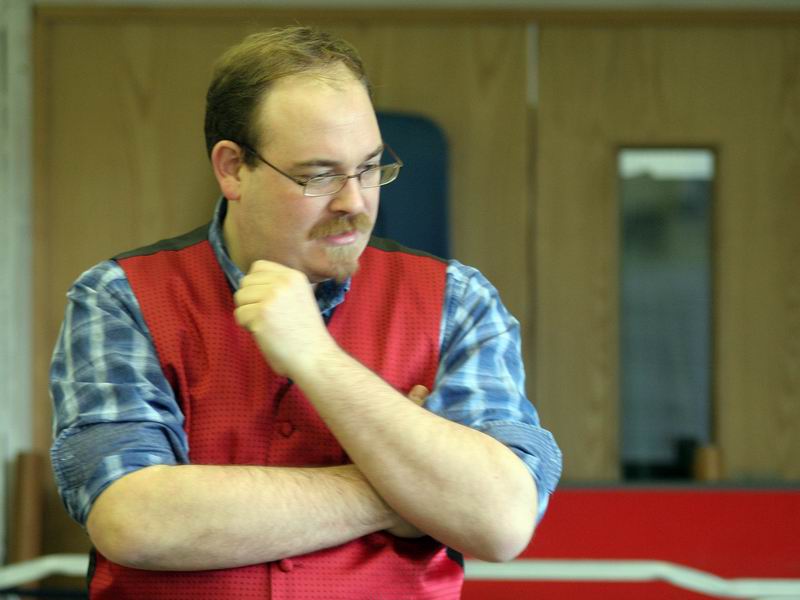Jean-Louis, responding to the last posting, lamented the lack of pics as regards uniforms. I accept that, apart from in the first Fictitious Wars posting, pics have been scarce. Partially this is due to me being less than happy with some of my earlier work, the painting being very rudimentary, and partly because when these battles were fought I did not take any pictures anyhow.
Many of you will also wonder why the bases are not textured. This is deliberate. Army reforms may take place that alter the basing, either increasing or decreasing battalion size or going to three rank line. The latter is clearly defined by looking at the number of figures per base. Franconia and many Northern League states are on 4 rank lines (represented by 3 bases of 4 figures) whilst Alsatia has already adopted 3 rank lines (4 bases of 3 figures). The cavalry, less prone to this sort of thing, is left un-textured as it would make the infantry look even less good!
Infantry Uniforms of Franconia
Franconia had a total of 27 numbered infantry regiments in 1750. There were: three Guard Regiments of two battalions, three Foreign Regiments of two battalions and two grenadier companies, six Fusilier regiments of one battalion, two Garrison Regiments of two battalions and two grenadier companies, the Lieb-Grenadier battalion and 12 infantry regiments of two battalions and two grenadier companies. Each battalion also had a depot company of 225 men.
In looking at the infantry uniform for Franconia I decided to use the SYW Revell Austrian figures as the basic figure type although some units were to use the Prussians. For the colours I decided upon a slightly off-white coat with white cross-belting as standard for virtually all infantry regiments save the 3 Guard Regiments and the Lieb-Grenadiers. Tricorn lace would always be white, and gaiters black although, once again, the Guard would be in linen. Flags would be only one for the first battalion (due to a shortage of standard bearers rather than any other reason) and I painted one side with a national (lieb) colour and the other representing the ordinance colour.
The remainder I left somewhat haphazard. Some units have lapels, others do not. The most a unit will have faced is waistcoat, breeches, cuffs, lapels and turnbacks, but having the whole 9 yards is unusual and usually some of these are left in the coat colour.
The ‘weak’ white colour also has several other reasons. One it maintains that notion of ‘Catholic’ countries having white as the basic uniform colour. Secondly it allows the use of a whole variety of facing colours that do not look as strong on darker shades, such as blue allowing the use of colours such as Rose Pink, for example, without it looking lost.
There are also 3 foreign regiments: Van Pfeffer’s Dutch, the Royale Gaulois and Hamilton’s Scots. These are, again, uniformed slightly differently. Van Pfeffer’s unit (see below) is in grey faced orange with straw small clothes, Hamilton’s is in dark blue faced white whilst the Royale Gaulois have a dyed white coat faced blue, including small clothes.
Grenadiers of all units wear a bearskin and have a match case, there are currently two companies per regiment.
 (left to right) Grenadier companies of IR15 'Hamilton', IR12 'Waldgraf von Baden-Durlach' and IR16 'Herzog von Hohenzollern-Hechiggen'
(left to right) Grenadier companies of IR15 'Hamilton', IR12 'Waldgraf von Baden-Durlach' and IR16 'Herzog von Hohenzollern-Hechiggen'There are also six single-battalion fusilier regiments. These figures are modified Austrian Grenadier figures and are not that different from the line regiments in performance. They were just a bit of added fun to the infantry orbat.
Regular Cavalry
The regular cavalry is divided into Kurassier (5 regiments of 6 squadrons), Dragoons (six regiments of 5 or 7 squadrons) and Hussars (4 regimentsof 4 squadrons, except Lib-regiment which has six) and 3 regiments of Guard (4 squadrons each).
The Kurassier all have the off-white coat with various facings displayed as per the line infantry.
The Dragoons are more colourful. Of the six regiments, three have green coats, two have blue and one is in red. Each regiment has a squadron of Horse Grenadiers in bearskin (the old Airfix AWI officer figures coming in useful here).
The Hussars are all in Mirliton (Revell SYW Prussian Hussar figure) and are based in a looser looking order than the Dragoons or Kurassier.
The Guard
The Royal Guard comprises 3 regiments of infantry (Garde-Grenadiere, Garde-Fusiliere and Garde-Musketiere) of 2 battalions each and 3 regiments of cavalry (Garde-du-Corps, Garde Karabinier and Garde Husaren).
They, more so than the army in general, are uniformed according to the red/white national colours. White is dyed white, rather than off-white and the infantry sport white linen as opposed to black gaiters.
The Garde-Grenadiere (and Lieb-Grenadiers too) wear the older-style metal-fronted mitre rather than the bearskin worn by Grenadiers of line regiments.
Light troops and Freicorps
There are two units of regular Jager in the army. The Franconia Feldjagercorps is recruited from huntsmen and foresters on the Royal estates, whilst the Schwarzwald Jagercorps is recruited in the Black Forest. Both units wear a white laced tricorn, a green coat with unbleached woollen breeches and black gaiters and are rifle armed. The Franconia Feldjager have brick red cuffs and turnbacks with the Schwarzwald battalion in purple. There are two other Jager units, the Land-und-Feld Jager battalions of Von Giessenburg and Von Reubersberg. They are semi-regular units raised to defend the long and difficult Black Forest area but, in 1750, they were pressed into service with the field armies. Von Giessenburg has light brown facings, Von Reubersberg dark blue but otherwise they are uniformed as the regular battalions.
In 1750 there were 3 pre-war freicorps units. The oldest is Farinelli’s freicorps, raised from the Neapolitan escort to the then Princess Maria in 1717 and continually refreshed with additional Italian recruits. It has gradually lost its Neapolitan character but was still led by Count Rudolfo Farinelli who also doubled as Neapolitan Ambassador. The unit in 1750 was made up on two battalions of infantry in white faced yellow wearing a bearskin with a yellow flame, and two squadrons of dragoons/light cavalry uniformed similar to the infantry but in tricorn with yellow lace.
The second freicorps raised was that of Prince Aleksandr Kliuchevski, a major figure among the Ruthenian community that had been allowed to settle in Franconia after being driven from their homes by the Lithuanians. Raised for the Bamberg campaign in 1740 and kept alive by Prince Kliuchevski, the unit in 1750 comprised 3 battalions of infantry and two squadrons of hussars. Uniformed in claret with black leatherwork and tricorn with white lace, the hussars had claret dolman and breeched with black pelisse, white colpack and red bag.
The most recent Freicorps was raised in 1748 by Prinz Moritz, the Prince of Auersperg and Johann’s youngest son. Wearing a grey coat with claret cuffs, breeches and waistcoat it also wore a curious casquet of leather faced with a brass plate.
Artillery
The Franconian artillery is divided into 3 branches, the Feld-Artillerie Regiment, the Bombardier-Corps and the Festungs-Artillerie. All are uniformed in a similar fashion of claret coat with white cuffs and turnbacks and waistcoat with a black tricorn with white lace. The Feld-Artillerie regiment has off-white breeches and black boots, the Bombarier-Corps claret breeches and black boots whilst the Festungs-Artillerie has claret breeches and un-dyed linen gaiters.
The three units have different functions. The Feld-Artillerie were composed in 1750 of 14 companies mostly armed with 3 pfund kanonen whose main function was artillery support for the army in the field. The Festungs-Artillerie provided fortresss gunners around the kingdom (usually recruited from older members of the other two units) but also provided 3 siege companies, one of which was equipped with mortars. The Bombardier-Corps manned the 18 pfund guns and 10 pfund howitzers and sat uneasily between the two, and in 1750 comprised only two companies.
Other units
There were also 12 battalions of militia in 1750, the militia wore a blue coat with facings dependent on region. There also existed 4 pontoon trains, 4 companies of sappers and one company of miners.
Conclusion
I hope this little tour provides some guide to the forces and uniforms of Franconia, and I will cover Alsatia and some Northern League states in the near future.
J






















7 comments:
Very nice description of your units, and useful as I spotted some conversions I could use for my forces. Thanks and keep up the good work
John,
thank you warmly for that magnificient tour of the Franconian forces!
Of course I'll be not the onlo oneto greatly enjoy it.
You are too modest by far, your army is a real eye-candy. The 'internal logic', self-consistency and accurate historical basing (e.g. Catholic infantry in ±white) are exemplar.
If some day me manage, as a group effort, to compile a web version of a "Mythical Armies of the Lca Wars" Funcken, your armies will be a great contribution to it!
Compliments,
Jean-Louis
Compliments;
John,
sorry if I already pester you with the suggestion, but what about having the Alsatian-Franconian sphere joining the 'EvE' campaign?
Room is emphatically not a problem on the map of this 'Europe'!
If you don't your countries to be involved in the Gallia-Hesse-Seewald campaign, you can claim total neutrality, yet be part of the exchange of (light-heated) diplomatic missives?
John,
unless there is a *huge* problem of size/ scale of the minis, your 'Rondas Volantes de Catalunya' could make some colourful 'Chasseurs de Montagne' in your Alsatia-Franconia campaign.
Jean-Louis,
In case you hadn't noticed, John is already a member of "Emperor vs Elector". He has chosen the Abbey of Kempten as his imagi-Nation.
John, the Franconian army is very impressive. It would be great to see it "en mass" at some future point.
Good posts.
-- Jeff
Guys
I chose deliberately not to include the current Fictitious Wars campaign because it would both muddy the ongoing campaign as it stands (in both cases) and I wanted something small for EvE, frankly in case I did not enjoy it.
Regarding 'en-masse', well, there is a large battle looming at Tauberbischofsheim, the first Franconian effort to relieve Wurzburg opposed by the Prince of Hessenstein's covering army. I have a few more units to paint and the account of the battle of Hardheim to post and then we will be ready.
J
John,
I hope you enjoy your contribution to 'EvE': certainly we do!
Jean-Louis
Post a Comment